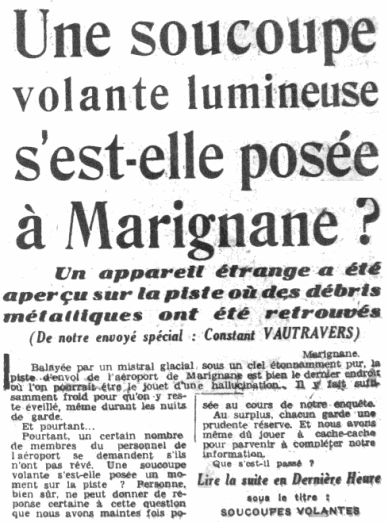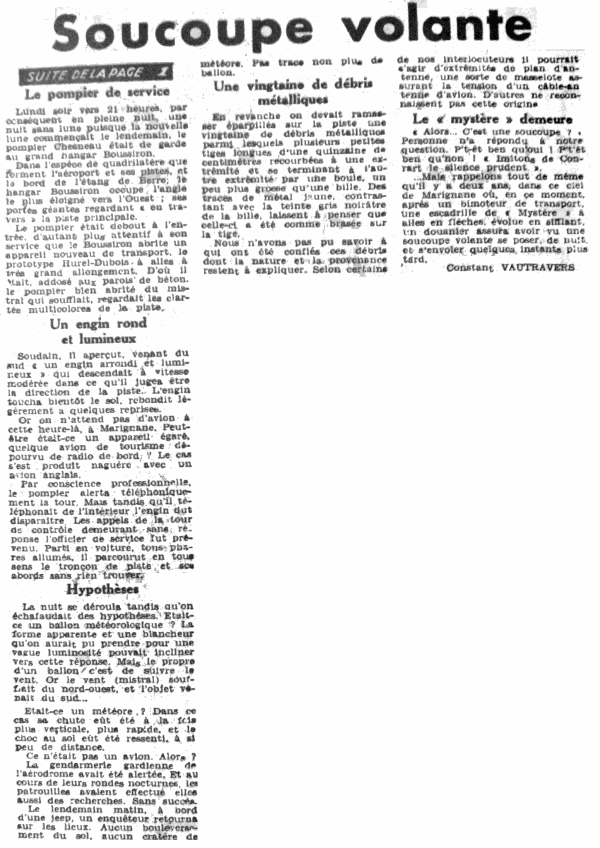
This article was published in the daily newspaper Le Provençal, France, page 1, on January 8, 1954.

|
A strange apparatus was seen on the track where metallic remains were found
(From our special correspondant Constant VAUTRAVERS)
Swept by an icy mistral [cold wind of the area] under a sky amazingly clear, the runway of the airport of Marignane is really the last place where one could be the subject of an hallucination. It is sufficiently cold there so that one remains awaken, even during the nights of guard.
And yet...
However, a certain number of members of the personnel of the airport wonder whether they did not dream. Did a flying saucer land one moment on the track? Nobody, of course, can give an unquestionable answer to this question which we asked many times during our investigation.
Au surplus, chacun garde une prudente réserve. Et nous avons même du jouer à cache-cache pour parvenir à compléter notre information.
Furthermore, each one keeps a careful reserve. And we even had to play hide-and-seek to manage to supplement our information.
What happened?
Read the rest in Las Minutes under the headline FLYING SAUCERS

|
The fireman on duty
Monday evening around 9 p.m., consequently in middle of the night, a moonless night since the new moon began the next day, fireman Chesneau was of guard at the large Boussiron hangard.
In the sort of quadrilateral that the airport and its tracks are forming, and the edge of the pond of Berre, the Boussiron hangard occupies the most distant angle towards the West; its giant doors look "transversely" at the main track.
The fireman was standing at the entry, all the more attentive since Boussiron houses a new transportation craft, the Hurel-Dubois prototype with wings of very great lengthening. From where he was, leaned on the concrete walls, the fireman, well sheltered from the mistral which blew looked at multicoloured clearnesses of the track.
A round and luminous craft
Suddenly, he saw, coming from the South, "a round and luminous craft" which went down at moderate speed in what he judged to be the direction of the track. The machine soon touched the ground, rebounded slightly a few times.
However one does not await a plane at that hour, in Marignane. Perhaps this was a mislaid airplane, some private plane deprived of on-board radio? This happened once with an English plane.
By professional consciousness, the fireman alerted the tower telephonically. But while he phoned from the inside, the craft had to disappear. The calls of the tower of control remaining without answer the duty officer was alerted. Left by car, all headlights lit, he crossed the section of track and its surroundings in all directions without finding anything.
Assumptions
The night proceeded while assumptions were made. Was this a weather balloon? The apparent shape and the whiteness that could have been mistaken for a vague luminosity could incline towards this answer. But the characteristic of a balloon is to follow the wind. However the wind (mistral) blew from the North-West, and the object came from the south...
Was this a meteor? In this case its fall would have been at the same time more vertical, faster, and the shock on the ground would have been felt, as a so little distance.
It wasn't an airplane. So?
The gendarmerie, guardian of the airport, had been alerted. And during their night rounds, the patrol had carried out searches too. Without success.
The following day morning, on board a jeep, an investigator returned on the spot. No upheaval of the ground, no meteor crater. Not trace of balloon either.
A score of metallic debris
On the other hand one was to collect, scattered on the track, a score of metallic debris among which several small long stems of about fifteen centimetres bent at an end and finishing at the other end by a ball, a little larger than a marble. Yellow metal traces, contrasting with the blackish gray colour of the ball, let think that this one was like brazed on the stem.
We could not learn which to whom these remains whose nature and source remain to be explained were entrusted. According to some of our interlocutors they could be ends of plans of antenna, a kind of mass to ensure the tension of an cable-antenna of plane. Others do not recognize this origin.
The "mystery" remains
"So... Is is a saucer?"
Nobody answered our question. Maybe it is, maube it ain't! "Let's imitate of Conrart the careful silence."
... But let us recall all the same that two years ago, in this sky of Marignane where in this moment, after a twin-engine of transport, a flotilla of "Mystères" [jet fighters] with sweptback wings, evolves while whistling, a customs officer ensured to have seen a flying saucer land, at night, and fly away a few moments later.
Constant VAUTRAVERS